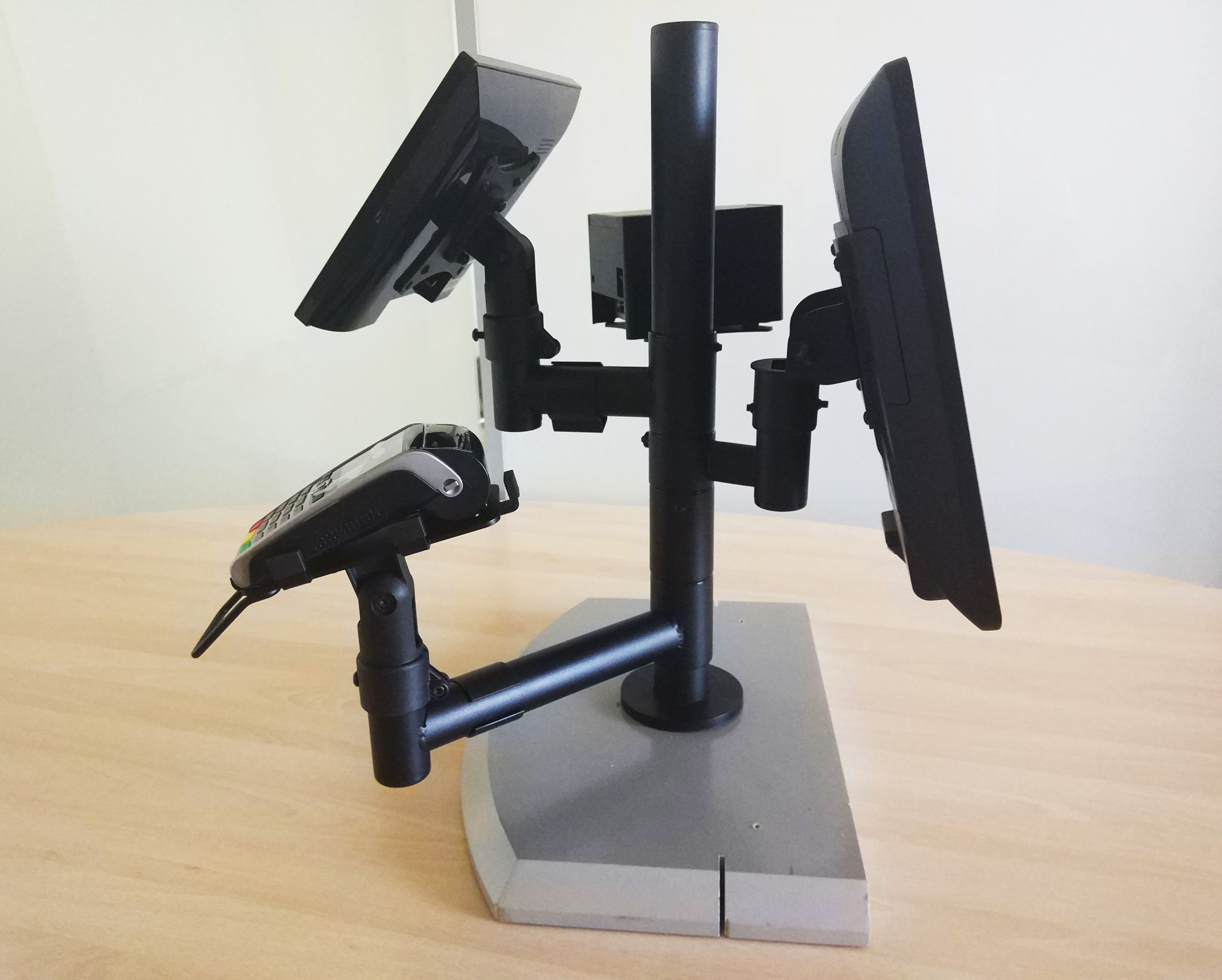Playing Cap: how to put the cashier on the cashier's table
Friends, now we are going to talk about such elementary things that even Captain Obviousness would get bored and go to deal with more complicated questions. It would seem, what could be mysterious with the location of cash equipment at the cashier's place? But, as our practice has shown, sometimes the most obvious topics in retail lead to unexpected turn of events.

The problem actually lies on the surface: it is not enough just to buy cash register equipment, you still need to manage to correctly position it on the cashier’s table. You ask, what is so difficult? In fact, it is really not easy. On average, a retailer needs to choose and buy:
At the same time, it is necessary to prevent the “zoo” of equipment - otherwise, in order to make friends the devices, a lot of dances with a tambourine will be required. This problem is removed ready sets cash registers. For example, the Pilot kits include all the equipment and software needed to start the cash register.
')
But here another question arises: the place of the cashier is so small. And then there is the steady trend of recent years: retailers realized that the cash hub is a great opportunity for pre-sales, and they are trying to make it as commodity as possible. Simple psychology: while you are waiting for your turn to the cashier, you will probably begin to consider chocolates, chewing-gum, lanterns, pens laid out at the box office and next to it. There is a high probability that, having twisted the product, you will add it to your purchases.
So, we repeat the conditions of the problem once again: there is not enough space at the cash node, a lot of commercial equipment, and there would also be room for goods. Question: how?

The first option is to buy small-sized equipment. For example, many of our clients are now waiting for the Pilot to release a very small CCP, so to speak, a mini. Another example: retailers install small sensory cash registers with a screen of 10 ". But even choosing the smallest equipment, a lot of space does not win. Moreover, there is also a problem with wires that constantly interfere, get confused, break.
The second option is even simpler: “How to save space on the cashier's place?” - but simply do not put commercial equipment on it. More precisely, almost not to put - just fix it on a special stand. In this case, all the equipment will be placed above the cashier's table, thus freeing up space on it. Starting to develop this idea, we are faced with the fact that the purchase of separate stands - when each device is installed on a separate - for the retailer it turns out the invoice. The cost of a desktop stand is from $ 50 to $ 75 for POS systems, the cost of a desktop stand is 20 - $ 30 for a second monitor 8 '' - 17 '', the cost of a desktop stand for a customer display is $ 10 - $ 15.
Conclusion, it is more profitable to put all the devices on one stand - so it will be both compact and inexpensive (saving from 4 to 6 thousand rubles). We have such an octopus:





As we have said, all the equipment is not on the table. The elements are mounted on universal supports: for small devices 7.5 by 7.5 cm, for large devices - 10 by 10 cm (the device on the stand is fixed with bolts, lightweight construction - on a double adhesive tape). As practice shows, displays larger than 21 ”retailers at the checkout and do not place. The EFT terminal on the stand can be rotated 270 degrees vertically and 180 degrees horizontally.
All cables are placed inside the stand: they do not hang, do not spoil the picture, do not tear. If you need to put a wide plug, it can be fixed with special fastening elements
The stand is convenient to use: the customer’s display is arranged so that the customers of the store can easily see all the information. At the same time, when there are few people in the store, the cashier can easily be turned into an information center: the cashier, together with the customer, can look at the customer’s display, for example, what sizes or colors of clothes of interest are available.
Yes, we talked about obvious things: so what’s clever here is to place cash equipment on one special stand? But retailers are only now beginning to realize that such an arrangement of equipment is beneficial for them in several ways:


Everyone says "Buy an elephant", and you take and buy an elephant
The problem actually lies on the surface: it is not enough just to buy cash register equipment, you still need to manage to correctly position it on the cashier’s table. You ask, what is so difficult? In fact, it is really not easy. On average, a retailer needs to choose and buy:
- POS-terminal and cashier's display (or, in the case of a touch-desk cash register, a monoblock combining both of these devices);
- customer display (ideally LCD display, not a two-line display);
- cash register equipment (CCP);
- EFT terminal;
- money box;
- Barcode Scanner.
At the same time, it is necessary to prevent the “zoo” of equipment - otherwise, in order to make friends the devices, a lot of dances with a tambourine will be required. This problem is removed ready sets cash registers. For example, the Pilot kits include all the equipment and software needed to start the cash register.
')
But here another question arises: the place of the cashier is so small. And then there is the steady trend of recent years: retailers realized that the cash hub is a great opportunity for pre-sales, and they are trying to make it as commodity as possible. Simple psychology: while you are waiting for your turn to the cashier, you will probably begin to consider chocolates, chewing-gum, lanterns, pens laid out at the box office and next to it. There is a high probability that, having twisted the product, you will add it to your purchases.
So, we repeat the conditions of the problem once again: there is not enough space at the cash node, a lot of commercial equipment, and there would also be room for goods. Question: how?

Surface answers
The first option is to buy small-sized equipment. For example, many of our clients are now waiting for the Pilot to release a very small CCP, so to speak, a mini. Another example: retailers install small sensory cash registers with a screen of 10 ". But even choosing the smallest equipment, a lot of space does not win. Moreover, there is also a problem with wires that constantly interfere, get confused, break.
The second option is even simpler: “How to save space on the cashier's place?” - but simply do not put commercial equipment on it. More precisely, almost not to put - just fix it on a special stand. In this case, all the equipment will be placed above the cashier's table, thus freeing up space on it. Starting to develop this idea, we are faced with the fact that the purchase of separate stands - when each device is installed on a separate - for the retailer it turns out the invoice. The cost of a desktop stand is from $ 50 to $ 75 for POS systems, the cost of a desktop stand is 20 - $ 30 for a second monitor 8 '' - 17 '', the cost of a desktop stand for a customer display is $ 10 - $ 15.
Conclusion, it is more profitable to put all the devices on one stand - so it will be both compact and inexpensive (saving from 4 to 6 thousand rubles). We have such an octopus:





As we have said, all the equipment is not on the table. The elements are mounted on universal supports: for small devices 7.5 by 7.5 cm, for large devices - 10 by 10 cm (the device on the stand is fixed with bolts, lightweight construction - on a double adhesive tape). As practice shows, displays larger than 21 ”retailers at the checkout and do not place. The EFT terminal on the stand can be rotated 270 degrees vertically and 180 degrees horizontally.
All cables are placed inside the stand: they do not hang, do not spoil the picture, do not tear. If you need to put a wide plug, it can be fixed with special fastening elements
The stand is convenient to use: the customer’s display is arranged so that the customers of the store can easily see all the information. At the same time, when there are few people in the store, the cashier can easily be turned into an information center: the cashier, together with the customer, can look at the customer’s display, for example, what sizes or colors of clothes of interest are available.
Yes, we talked about obvious things: so what’s clever here is to place cash equipment on one special stand? But retailers are only now beginning to realize that such an arrangement of equipment is beneficial for them in several ways:
- saves space on the cashier's desk;
- is inexpensive;
- the equipment is convenient to use both the cashier (the cashier itself, the scanner, the CCP), and the customer (the customer’s display, the EFT terminal).

Source: https://habr.com/ru/post/358244/
All Articles